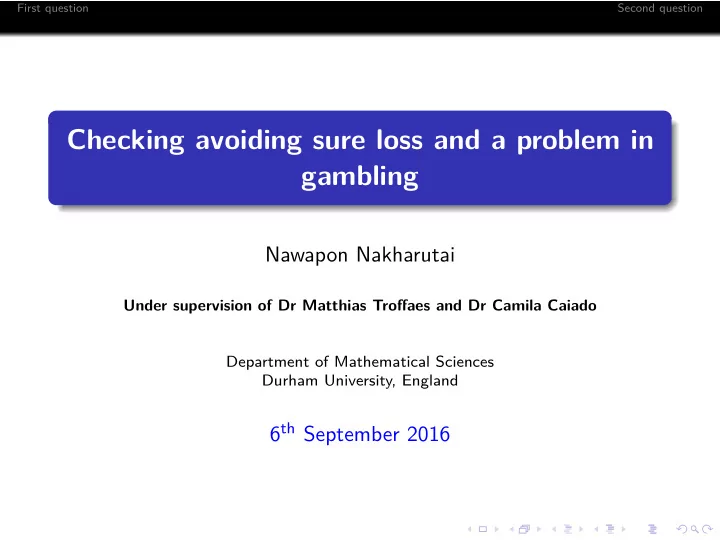

First question Second question Checking avoiding sure loss and a problem in gambling Nawapon Nakharutai Under supervision of Dr Matthias Troffaes and Dr Camila Caiado Department of Mathematical Sciences Durham University, England 6 th September 2016
First question Second question Avoiding sure loss A possibility space X A gamble g A set of desirable gambles D Desirability axioms D avoids sure loss if for all n ∈ N , g i ∈ D and λ i ≥ 0: � n � � sup λ i g i ( x ) ≥ 0 . (1) x ∈X i = 1
First question Second question Linear programming problems We can check whether D avoids sure loss by solving linear programming problems � (D) ∀ g i ∈ D : g i ( x ) p ( x ) ≥ 0 (P) min α x ∈X n � s.t. ∀ x ∈ X : λ i g i ( x ) ≤ α � p ( x ) = 1 i = 1 x ∈X where λ i ≥ 0 . where p ( x ) ≥ 0 .
First question Second question Gambling company Consider a gambling company offering bets Can we exploit this situation to make a profit? On the other hand, if we were the betting company, then we would like to prevent gamblers to earn money.
First question Second question Formulate a problem We can view these odds as a set of desirable gambles D to the company. This set avoids sure loss = ⇒ the company avoids sure loss. Checking whether D avoids sure loss is very quick. Theorem 1 Let X = { x 1 , ..., x n } . Suppose a i / b i are odds on x i where a i and b i ≥ 0 . For each i = 1 , ..., n, � − a i if x = x i g i ( x ) := (2) b i otherwise . Then D = { g 1 , ..., g n } avoids sure loss if and only if n b i � ≥ 1 . (3) a i + b i i = 1
First question Second question Gambling company Consider several gambling companies offering bets
First question Second question Theorem 2 Let X = { x 1 , ..., x n } . Suppose there are m different companies. For each k = 1 , .., m, a ik / b ik is betting odds on x i provided by company k where a ik and b ik ≥ 0 . For each i = 1 , ..., n and k = 1 , ..., m, � − a ik if x = x i g ik ( x ) := (4) b ik otherwise . Let a ∗ i / b ∗ i be the maximum betting odds on outcome x i , that is, a ∗ i / b ∗ i := max { a ik / b ik } . (5) k Then D = { g ik : i = 1 , ..., n , k = 1 , ..., m } avoids sure loss if and only if n b ∗ � i ≥ 1 (6) a ∗ i + b ∗ i i = 1
First question Second question Free coupons Suppose the company offers an extra bet which is not fit for eq. (2). This bet can be viewed as another desirable gamble f . For example, a ”free coupon”. Check whether the company still avoids sure loss, i.e. whether D ∪ f avoids sure loss.
First question Second question Discussion 1 D ∪ f avoid sure loss if or all n ∈ N , g i ∈ D , λ i ≥ 0 and α ≥ 0: � n � � sup λ i g i ( x ) + α f ( x ) ≥ 0 . (7) x ∈X i = 1 E ( f ) := inf { α ∈ R : α − f ≥ � n i = 1 λ i g i , n ∈ N , g i ∈ D , λ i ≥ 0 } . Theorem 3 D ∪ f avoids sure loss if and only if E ( f ) ≥ 0 . A proof is easy and we can reduce the size of a linear programming problem. Q: Can we simplify this theorem, e.g. without solving a linear programming problem?
First question Second question Discussion 2 Two sets of desirable gambles D 1 and D 2 . D 1 : large, avoiding sure loss (formulate from given odds) D 2 : small (formulate from free coupons) Aim: check whether D 1 ∪ D 2 avoid sure loss? Possible way: add one desirable gamble to D 1 and check whether it avoids sure loss. Do we have a better way?
First question Second question Discussion 3 Get free coupon if you lose You first bet with the company, say Man city 11/8. If Man city wins, you get your reward. If not, the company give you a free coupon to bet on other tournaments. Aim: formulate this problem to a problem of checking avoiding sure loss.
Recommend
More recommend